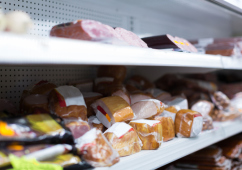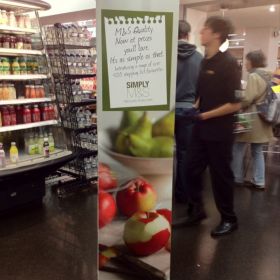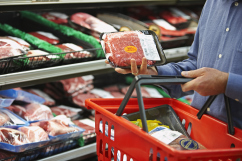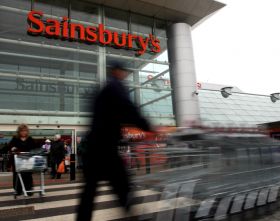Retailer Sales
Retailer reports ‘strong’ Christmas trading although saw sales fall by 1.5% during the third quarter
Tesco saw like-for-like sales rise by 1.3% during the key six-week Christmas trading period thanks to low prices and a strong “seasonal offering”.

In contrast, like-for-like sales fell by 1.5% during the retailer’s Q3 (13 weeks to 28 November), which the retailer said was down to not repeating ‘£5 off £40’ national coupon campaigns from the previous year.
Chief executive Dave Lewis said more staff on shop floors boosted sales over Christmas, which also saw volumes rise by 3.5% and transactions increase by 3.4%. He hailed the Christmas results as a “significant improvement” on recent years.
“Our Christmas performance was strong, benefiting from lower prices on an outstanding range of products,” Lewis said. “Our customer service improved materially and our colleagues went the extra mile.
“Through our ongoing investment in lower, more stable prices, we were around five per cent cheaper than last year on the lines that mattered most to our customers at Christmas.”
Lewis said strong Christmas performance was evident across all formats and categories, including positive like-for-like sales growth in Tesco Extra.
International sales have continued to grow, he continued, including positive sales momentum in Europe and Asia, and the Thai business reaching its highest-ever market share.
“There is plenty more to do, but we are making good progress and are trading in line with profit expectations for the full year,” he added.
Fresh meat and poultry sales have seen another decline in value sales. According to Kantar Worldpanel’s Meat, Fish & Poultry Market update for the 3 months to 8 November 2015, value sales dropped 0.7% while volume sales saw modest growth at 1.5%.

Lamb had a strong performance in the last 12 weeks compared to 2014, attributed to a strong performance from leg roasting joints. Pork saw continued decline in both value and volume, with 560,000 fewer households buying compared to last year.
Kantar Worldpanel added that British Sausage Week failed to drive sales, with the sausage category seeing a -4.7% and -6.8% decline in value and volume sales respectively. However, burgers and grills grew over the same period, experiencing a 7.3% increase in value sales and a 10.8% jump in volume sales.
While the Kantar Worldpanel data doesn’t take into account the impact of the recent World Health Organisation study into red and processed meat, IRI Retail Advantage, which measures sales across the major retail multiples, showed that since the week of the report (w/e 31 October) and the following week (w/e 7 November), losses in sales of sausages and bacon were estimated to be £3 million.
IRI reported that value sales of pre-packed sausages saw a decrease of -15.7% for w/e 31 October compared to the same week of last year while pre-packed bacon saw a steeper decline, with sales down -17%. The product has fallen -6.5% in the past quarter, and -5.6% in the last year, which is equal to a 10% fall in sales as a result of the WHO report.
The retailer said that it believed this was thanks in part to a Christmas direct marketing campaign “landing with customers”

Total divisional sales excluding fuel were up 4.7% on last year at Waitrose for the week ending 14 November 2015.
The retailer said that it believed this was thanks in part to a Christmas direct marketing campaign “landing with customers”.
Waitrose’s online channel also delivered, with grocery sales 26.1% higher than last year following a promotion.
Fruit performed well in the period covered, with frozen fruit up by a third, soft fruit up 9%, and pears up 4% respectively.
Sweet potato sales, meanwhile, were up 32% on the same week last year.
Going forward, M&S has planned and targeted to concentrate on increasing food sales

Sales at Marks & Spencer have fallen for the six months to the 26th of September.
UK like-for-like sales fell by 0.4% for the period, and while sales of general merchandise, which includes the clothing division, were down by 1.2%, food sales rose by 0.2%.
The retailer said underlying profits rose by 6.1% to £284 million, although after taking into account one-off items, pre-tax profit fell 22.7% to £216m.
Those one-off items included almost £27m on revamping UK stores and £22m on European store costs.
M&S noted that it plans to concentrate on increasing food sales, gross margins and cash generation.
Retailer’s pre-tax profit falls by almost half in H2 as it prepares to close 11 supermarkets and finalise sale of M Local
Morrisons will close 11 supermarkets and sell 140 of its convenience shops after reporting that like-for-like sales fell by 2.7% in the first half of this year.

The six month results to 2 August also saw total turnover fall by 5.1 to £8.1 billion while pre-tax profit fell by almost 50 per cent to £126 million.
M Local convenience shops, in the process of being sold, will be re-branded as ‘My Local’ with the 2,300 staff kept on. An extra 200 jobs are to be created by reopening 10 shops that are currently closed, the BBC reported. They are understood to have been bought by convenience veteran and former Spar man Mike Greene, backed by investment firm Greybull, according to the Telegraph.
Chief executive David Potts said he expects profit to be higher in the second half of the year, but stressed that recovery will be “a long journey”.
“The immediate priority is to deliver a better shopping trip to stabilise trading performance. Our six strategic priorities will then deliver improvement in the core supermarkets, where we have the greatest opportunity,” he said.
“It will be a long journey. We approach the challenge with energy, confidence and many strengths, particularly our strong balance sheet and cash flow, which enables investment in improving the customer shopping trip.”
Morrisons also named two new non-executive directors – Belinda Richards and Irwin Lee.
Chairman Andrew Higginson said: “David has very quickly formed a new team that combines the best of Morrisons home grown and external talent. I am also delighted that two new non-executive directors – Belinda Richards and Irwin Lee – have recently joined and strengthened the board. They bring a wealth of experience, which will prove invaluable to Morrisons.
“During the first half, the team has made good progress in starting the turnaround journey. While the management team need time to settle in, make the changes they see as important, and build trading momentum, I believe the team will deliver much improved profits and returns for shareholders.”
J Sainsbury’s has reported like-for-like retail sales down 2.1% excluding fuel during the 12 weeks to 6 June, 2015.
Total retail sales for first quarter were down by 0.6% (excl fuel) and also down 2.3% (inc fuel).
Mike Coupe, chief executive, said that “strong levels of food deflation and a highly competitive pricing backdrop” are impacting trading conditions.

He added that the grocer, which is known for its “differentiated offer”, introduced new products in several categories focusing on British sourcing wherever possible during the first quarter.
“We have also improved our seasonal fresh offer in time for summer. For example, our by Sainsbury’s BBQ Smoked Chilli Pulled Pork and by Sainsbury’s BBQ Sweet Chilli Chicken Thighs give customers meat cuts and flavours that are perfect for the barbeque,” he said.
“Volume and transactions continue to grow as customers are benefiting from our improved value and further investments in quality. We have simplified our promotional offer, which has reduced promotional participation further, helping to lower waste and give customers even better levels of availability. We committed to deliver our cost savings programme without impacting the customer experience.
“We continue to make it easier for customers to shop with us whenever and wherever they want. We have now opened 20 grocery Click & Collect sites and remain on track to have 100 sites by the end of 2015.”
Total sales fell 0.3% as price cuts and food deflation both affected trading
Sainsbury’s has warned it expects the market to “remain challenging for the foreseeable future” after reporting a drop in like-for-like sales for a fifth consecutive quarter.
It said sales at stores open at least a year fell 1.9% – excluding fuel – in the 10 weeks to 14 March.

Total sales fell 0.3% as price cuts and food deflation both affected trading.
Sainsbury’s said the drop in sales reflected the decisions the group had taken to improve its competitiveness.
David Tyler, Sainsbury’s chairman, said: “The UK grocery sector has become increasingly challenging in recent months.
“As a result, we have evolved our strategy and believe this will allow us to build on our heritage and past success, especially as it will be delivered by the most experienced management team in the industry.”
David Gray, a retail analyst at Planet Retail, isn’t so optimistic.
He said: “As expected, Sainsbury’s like-for-like numbers are now converging with its competitors with Q4 delivering another decline. This shows that even the former golden child of UK grocery is not immune to the double whammy of industry-wide sagging food volumes and price stagnation – a potent brew which is proving deadly to mainstream operators.
“With Tesco showing tentative signs of being ready to embark on the long slog to recovery, the challenges for Sainsbury’s will grow more daunting. The threat of more Tesco price investments is lurking in the background; something that could trigger a lengthy flatlining of food prices industry-wide.
“Although these figures are disappointing at best, Sainsbury’s still possesses some strengths, most notably in convenience where it continues to add one to two stores per week. Like-for-like performance is considerably better in convenience than big-box, though its growth this time around was insufficient to offset declines elsewhere.”
Like-for-like sales also increased by 2.8% at the retailer for the five weeks ending 3 January 2015
Total sales (excluding fuel) were up by 7.0% on the equivalent period at Christmas last year at Waitrose to £728 million.

Mark Price, Waitrose MD, said: “This strong sales performance in a tough trading environment is a tribute to all our partners who work so hard to give the high quality products and outstanding service that customers want all year round and especially at Christmas.
“As a business owned by the people who work here, we can take the long-term view and our Christmas results show the effectiveness of our strategy of investing in good value, in making our shops attractive destinations and in building our online business.”
Online sales also did extremely well compared to the same period last year.Grocery sales through Waitrose.com grew by 26.3%, with wines, flowers and hampers showing a 39% increase.
Premium retailer said food sales in Christmas week were up a record 17%, and like-for-like sales grew by 0.1%
Marks and Spencer’s food business grew like-for-like sales by 0.1% in the 13 weeks to 27 December.
Total food sales rose by 2.8%, while sales in the Christmas week were up 17%.

The premium retailer said it had seen “record Christmas sales” in food, which “strongly outperformed the market”.
Despite a strong performance in the category, total like-for-like UK sales for the company fell by 2.7%, after a terrible performance in its general merchandise division, which includes womenswear, and where like-for-like sales were down 5.8%.
“Our food business delivered another excellent quarter, significantly outperforming the market by around three percentage points,” said CEO Marc Bolland.
“We saw record sales over the festive period, up 17% in the key Christmas week. Customers once again turned to us for our highly differentiated food offer, combining the best of quality, seasonal speciality and convenience, all at competitive prices.
“We launched nearly 750 new products giving customers more choice than ever, with record results in turkeys, party food, desserts and deli,” he said.
Bolland said disruption at the company’s Castle Donington distribution centre “strongly impacted” .com and general merchandise performance in December.
And he said overall international business was “heavily impacted” by the worsening currency and economic issues across its Middle East and Russia franchise region, but the business had performed well in other key markets such as India.
M&S will report its fourth quarter trading results on 2 April 2015.